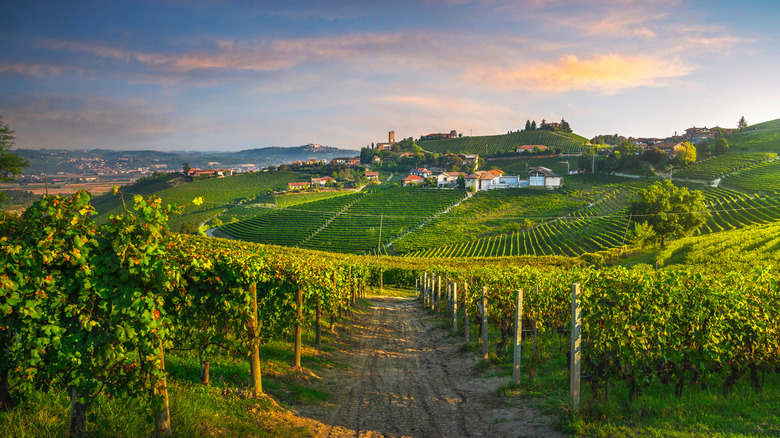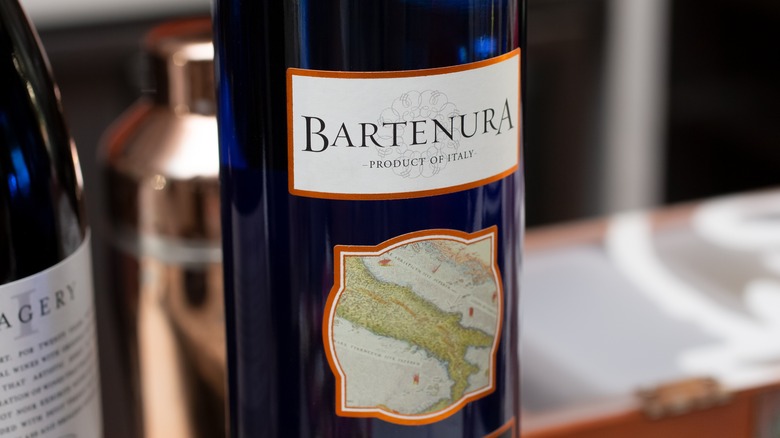What Exactly Is Moscato Wine?
Moscato is one of over 10,000 wine varieties recognized today (via Forbes). There are many different wines to choose from, but few are as ancient as the Moscato variety. Moscato, traditionally fermented from white wine grapes called Muscat (not to be mistaken for Muscadelle, Muscadine or Muscadet), and are believed by Bellissimo Wines to be one of the oldest wine grapes in the world. It was enjoyed by the ancient Greeks, centuries later by the Romans, and now, in the 21st century, we partake in growing and drinking all Moscato's sub-varieties.
The wine is not as popular as other white wine varietals such as Chardonnay, Sauvignon Blanc, or Pinot Gris, but for those who enjoy whites like Rieslings and Gewürztraminer, Moscato is definitely up your alley. And if you don't know what you like, that's okay too. The following paragraphs will give you a better understanding of what Moscato tastes like, where it's grown and how to drink it.
What is Moscato?
For those of you who have yet to sip on a glass of Moscato, you may not know whether this wine is sweet or tart, but according to Italy Abroad, there are different Moscato styles grown all over the globe. In France it is called the Muscat, in Spain and Portugal it is called the Moscadel, but the Moscato grape is typically considered an Italian varietal because this country produces more Moscato than any other in the world.
Wine Folly states that Moscato is made from Muscat Blanc grapes, so the wine usually appears pale or gold in hue, but Moscato can be made into various wine styles, including sparkling and semi-sparkling, still, a dessert wine, Red Moscato aka Black Muscat (which pressed from a unique cross-breed of Schiava and Muscat of Alexandria grapes), and Pink Muscat (though this not a pure Moscato because it is blended with Merlot for the color). Each of these varieties highlights different flavor nuances and pairs with different dishes. Yet, out of all these styles, Marketview Liquor says that the most common kind you'll find is the Moscato d'Asti, which is a sweet semi-sparkling wine.
What does Moscato taste like?
So while it can come in pink or red, the Moscato is most commonly considered a white wine. Food & Wine describes the Moscato as having unmistakable fruity, floral notes, low acidity, and recommends the most common sparkling or white varieties should be served between 40-45°F. If you tend to prefer wines that are more acidic, tart, or dry, Moscato probably isn't for you as they tend to be sweet and have a lush mouthfeel.
Foods Gal says the Moscato can be paired with several dishes to highlight its natural fruit-forward flavor. Moscato is widely considered a dessert wine, lending its floral characteristics to desserts and dishes with fruit to enhance the dish's natural sweetness. But just because a Moscato is on the sweet side doesn't mean it has to pair with sweet things! The white wine is also a great way to balance out spicy or salty food. Food Gal points out that it works great with spicy Asian foods, so if you're a fan of yam khai dao or dan dan noodles, definitely request Moscato when dining out. It can also work well with more savory foods like cured meats and hard cheeses, so start planning your charcuterie board now.
How is Moscato made?
Moscato is grown in various ways around the world, and saying that a wine falls under the umbrella term of "Moscato" can leave many drinkers wondering whether they are about to receive a still, sparkling, or fortified wine. Additionally, Wine Country points out that while Moscato is traditionally sweet and lower in alcohol, if fermented, it can become dry or semi-sweet. By fermenting this varietal so that most of the sugar has dissipated, the Moscato will be left with lighter tropical and floral notes. These low-sugar Moscatos will be more palatable for wine lovers who don't care for saccharine vino.
Because Moscato has so many varieties, there is no single method for making it. Like many other wines, it differs from region to region, winemaker to winemaker, grape variety to grape variety, of which there are over 200. It is totally up to the vintners as to how sweet, dry, sparkling, or still, their wine turns out (via Food & Wine). That being said, Moscato is most commonly made from Muscat Blanc à Petits Grains, which Muscat-Wines considers to be the oldest and most concentrated variety of Muscat. This species is a white, small-berry grape harvested for all kinds of Moscato-style wines, and is even used in table blends.
Where to buy Moscato
There are several major styles of white wine you must familiarize yourself with in the wine world including Sauvignon Blanc, Chardonnay, Riesling, Pinot Grigio, Chenin Blanc, Viognier, Albariño, Sémillon, Gewürztraminer, Torrontés, and of course the Moscato. Unfortunately, not everyone has the opportunity to fly to Italy in order to try the country's Moscato d'Asti or Moscato Giallo. Luckily, thanks to a massive and collaborative global wine market, wine varietals grown all over the world can now be found at a Bottle Barn or Wine & Spirits shop or, depending on where you live, at a local tasting room.
Vinepair lists the top ten most popular Moscato brands such as Villa Alena Peach Moscato (Italy), Muscador Cepage Muscat Mousseux Rosé (France), Bottega 'Petalo Il Vino dell Amore Moscato' Spumante Dolce Colli Euganei (Italy) Robert Mondavi Winery Moscato d'Oro (Napa Valley), and Massandra Collection White Muscat (Crimea). But Liquor also suggests using their online store to browse the ten best and most affordable Moscato wines available to purchase easily and have delivered right to your door. Wiens Cellars recommends drinking a Moscato before it ages two years, as over time it will lose its characteristic sweet flavor as it ages — unless you're into that sort of thing.



